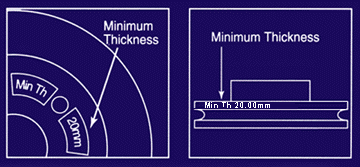Thickness new : 28 mm
Thickness minimum: 26.4 mm (1.039 ")
Minimum specs are punched in the discs.

In case you have 302X22 front disk rotors, then of course the min. is different.
Just go and look at your rotors. http://www.nmia.com/~dgnrg/rb-06.jpg
That is from the rear brake. Besides that have a look into the Bentley repair manual.
The Importance of Observing "Scrap Thickness"
DEFINITION
Scrap Thickness - also known as Minimum Thickness, RMT (Rotor Minimum Thickness) and Discard Thickness - is a measurement determined by a motor vehicle-maker during the design phase.It defines the thickness at which a disc rotor must be replaced because it can no longer deliver the braking performance expected of it. Observing scrap thickness guidelines is vitally important to road safety.
RISKS
Though less conspicuous than minimum tyre tread depth (due to brake components being out of view), Scrap Thickness is every bit as important in safety terms.In the same way as poor tyres will negate the benefit of good brakes, a braking system which is not operating at its optimum can render useless a vehicle's other active safety systems. Using rotors which have reached Scrap Thickness will lead to lowered braking performance and can even result in brake system failure.
A wide criteria is used by each motor vehicle manufacturer to determine the appropriate Scrap Thickness for each rotor application. They include the braking system's capacity for:
Heat absorption and dissipation
Caliper piston retention
Brake pad retention, and
Brake fluid retention
To look at these in more detail:
Heat Absorption And Dissipation
The function of an automotive brake system is to convert a vehicle's kinetic energy into heat energy. In a modern disK brake system this is done when a driver pushes a brake pedal which activates a power-boosted hydraulic system. Hydraulic pressure forces pistons to move inside callipers at each road wheel. The piston movement in turn forces the brake pads in contact with the spinning rotor. The rubbing action between brake pads and the disc rotor generates heat which is then dissipated, mainly into the atmosphere by convection. As a rotor reduces in thickness, its ability to absorb and dissipate heat is lessened. Once Scrap Thickness has been reached, a significantly reduced braking capacity can result. Symptoms include premature fade and increased stopping distances.
Calliper Piston Retention
In the course of doing their job, disc brake rotors and pads experience wear. The machining away of rotor irregularities further accelerates the thinning process. As the rotor and pads become increasingly slender, the calliper piston needs to move further within the calliper body to force contact between pad and rotor. When Scrap Thickness is reached with fully worn pads, the extended piston may lack sufficient support within the calliper bore. This can cause it to jam in the bore, causing brake drag or lock. Brake drag will lead to excessive heat build-up and possible brake fluid vaporisation. The result: increased stopping distances and, potentially, half-system hydraulic failure.
Brake Pad Retention
The combination of fully worn brake pads and discs which are at Scrap Thickness can, in some calliper designs, allow the pad backing plate to jam between the calliper anchor bracket and rotor. This will cause either brake drag or wheel lock-up. Both can result in a loss of vehicle stability. An alternative scenario is that the pads will be torn completely free, severely impeding braking capacity and damaging other components.
Brake Fluid Retention
Under certain conditions when brake pads are fully worn and Scrap Thickness has been reached, the calliper piston may no longer form a hydraulic seal. This will result in leakage, causing increased stopping distances and, possibly, half-system hydraulic failure.